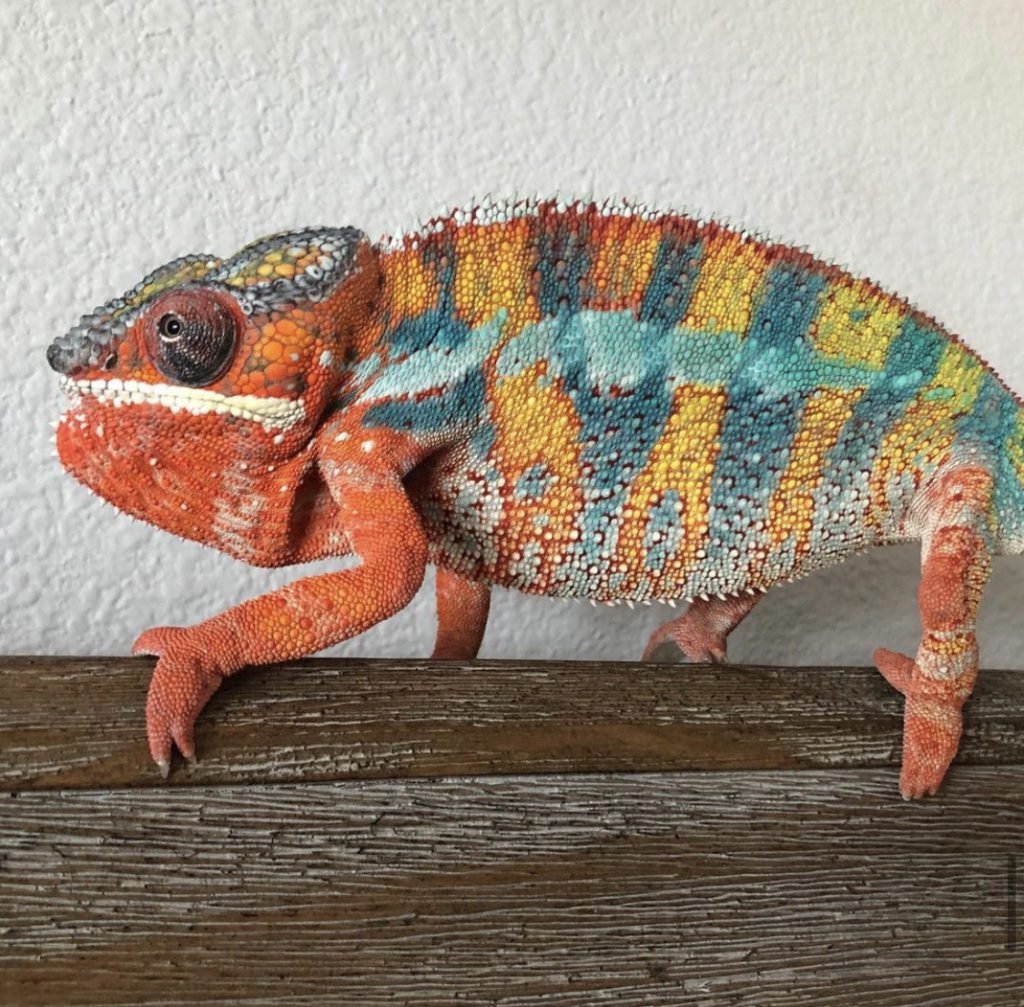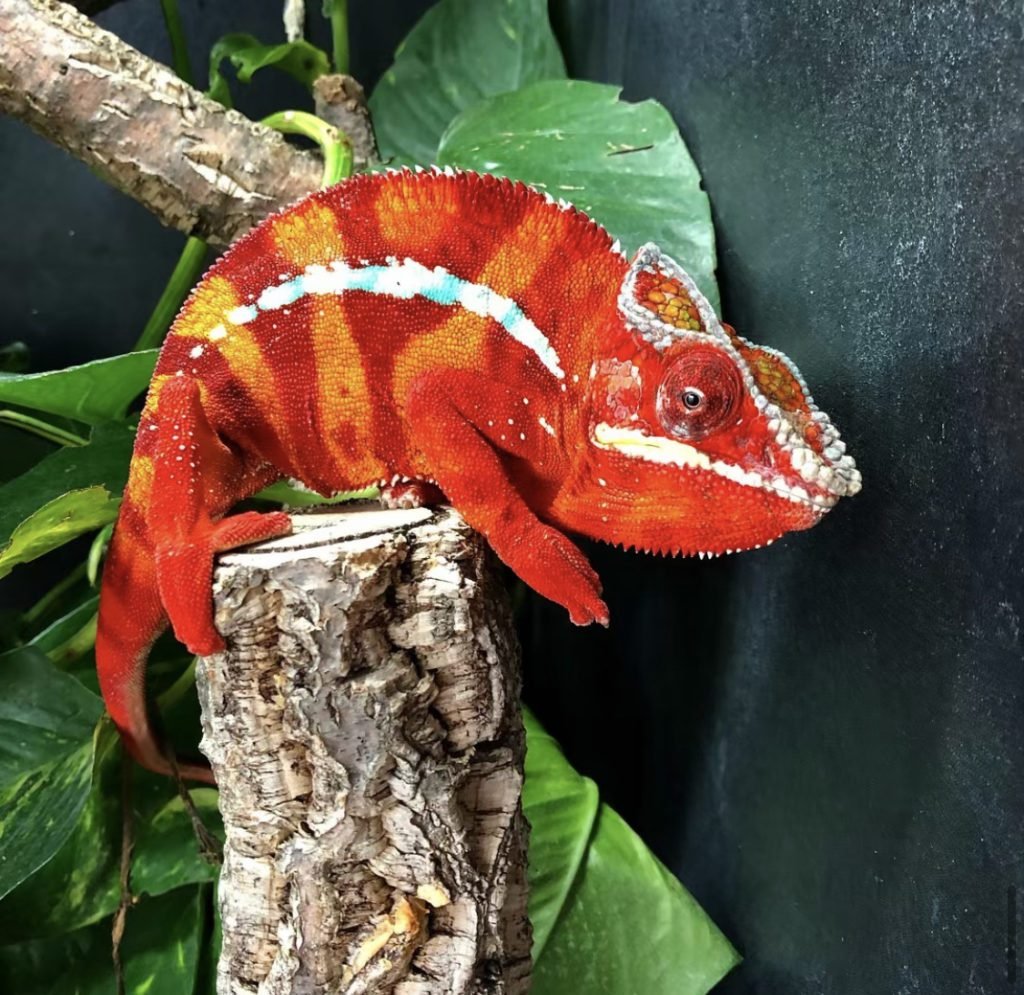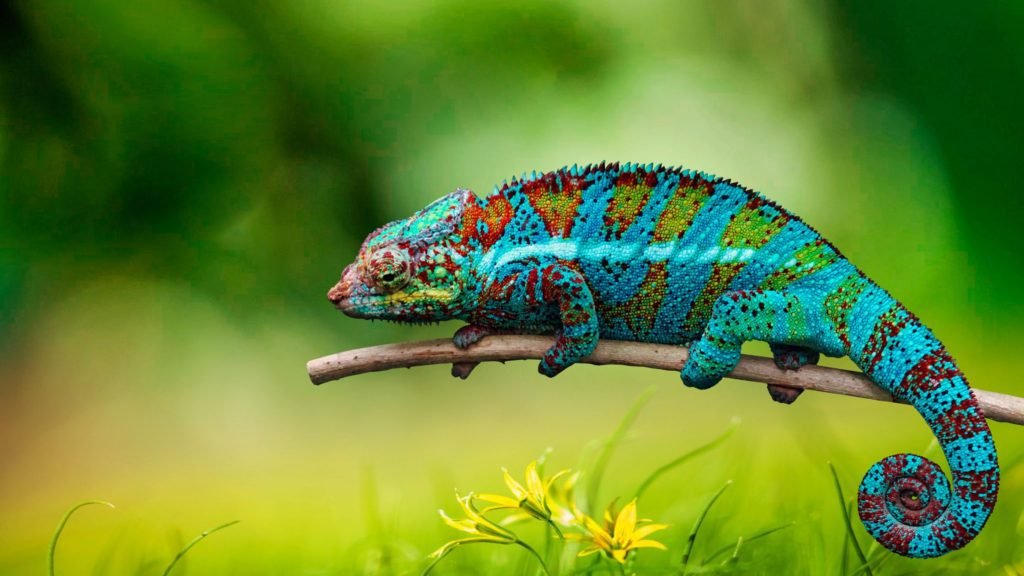Panther chameleons live in Madagascar’s woods and are famous for their camouflage. With its striking markings, iridescent scales, and formidable size, the panther chameleon is a true marvel of nature.
From a biological standpoint, the panther chameleon is a fascinating creature with many unique adaptations. These chameleons can hunt with laser precision because of their sharp eyesight and fast-moving tongues. Their brilliant greens, deep purples, and pinks attract mating, communicate, and defend them from predators.
Panther Chameleons Physical Characteristics
Size and weight
A panther chameleon is a formidable figure, ranging in size from 7-10 inches in length and weighing between 80-120 grams. Despite its compact stature, it boasts an imposing presence with its musculature and striking markings.
Color Pattern
The color and pattern of the panther chameleon are simply spellbinding. With the ability to change color based on its mood and environment, the range of hues it can display is genuinely mesmerizing. Panther chameleon scales glisten in the light, creating a rainbow of captivating patterns.
Anatomy and structure
But it is not just the panther chameleon’s color that sets it apart. Its anatomy and structure are truly remarkable. Its bulging, 360-degree-rotating eyes can monitor its surroundings like a professional sentinel. The panther chameleon’s lightning-fast tongue lets it catch food with extreme accuracy.

You may also interest: Why Do Chameleons Change Color? Uncover the Chromatic Wonders
Panther Chameleons Habitat and Distribution
Natural habitat
The panther chameleon calls the lush forests of Madagascar its natural habitat. Here, it thrives in the verdant jungles, basking in the dappled sunlight and hunting among the dense foliage. This diverse environment provides the panther chameleon with everything it needs to survive and flourish, from shelter to food to water.
Range and distribution
In terms of range and distribution, the panther chameleon is found throughout Madagascar and the nearby islands of Comoros and Mayotte. These areas offer the perfect climate and vegetation to support the panther chameleon’s unique adaptations and needs.
Captive environments
For those captivated by the panther chameleon’s beauty, it is also possible to keep these creatures in captive environments. The panther chameleon can thrive in captivity with the proper setup, including a spacious cage, adequate lighting, and a balanced diet. However, it is essential to note that captive environments can only partially replicate the diversity and richness of the panther chameleon’s natural habitat.
You may also interest: Everything You Need To Know About Creating the Perfect Chameleon Habitat
Panther Chameleons Behavior and Diet
Hunting and feeding habits
The panther chameleon is a skilled hunter, using its lightning-fast tongue to capture its prey. It feeds on insects, including crickets, moths, beetles, small lizards, and other invertebrates. With its keen senses and stealthy movements, the panther chameleon can stalk its prey and make a successful catch with remarkable efficiency.
Social behavior and communication
Regarding social behavior, panther chameleons are solitary creatures, only coming together to mate. However, they are only partially devoid of communication. They use a variety of signals, including color changes and vocalizations, to establish their territory and convey their moods and intentions to others.
Mating and reproduction
When it comes to mating, panther chameleons engage in a complex courtship dance, using their vibrant colors and impressive displays to attract a mate. Once a pair has bonded, the female lays eggs in a specially prepared nest, incubating until they hatch.
You may also interest: 20 Chameleon Facts: Exploring the Enthralling Chameleon World


Panther Chameleons Threats and Conservation
Threats to panther chameleon populations
The panther chameleon faces numerous threats to its populations, including habitat destruction, deforestation, and the pet trade. These activities rapidly reduce the number of panther chameleons in the wild and put their future at risk.
Conservation efforts and protection measures
Thankfully, there are conservation efforts underway to protect and conserve this species. These efforts include habitat restoration and protection, the regulation of the pet trade, and increased public awareness about the importance of preserving these magnificent creatures.
Role of the pet trade and captivity on conservation
While providing a source of income for local communities, the pet trade can also hurt panther chameleon populations if not properly regulated. Removing large numbers of individuals from the wild can upset the ecosystem’s delicate balance and decrease the overall population. Captive breeding programs are one solution, as they can reduce the demand for wild-caught individuals and provide a sustainable source of panther chameleons for the pet trade.
Panther Chameleons Price
Panther chameleon prices vary on age, size, coloring, and genetics. The range in price is between $50 to $1,000.
Panther chameleon ownership goes beyond the original purchase price. Its cage, warmth, lights, food, and medical care cost extra. Before getting a panther chameleon, examine your budget because these fees might add up rapidly.
Another factor to consider is the legality of owning a panther chameleon. Some states and countries have strict regulations on the ownership of exotic pets, including panther chameleons. Before buying, check local laws to prevent legal issues.
Panther Chameleons Lifespan
This chameleon’s species live up to 14 years in captivity. Many wild chameleons die from predators, illness, or other environmental risks.
Panther chameleons are not immortal. Like all living things, panther chameleons die from age.
However, with proper care and suitable habitat, panther chameleons can live long and healthy lives. Protein- and calcium-rich food and a warm, humid atmosphere can help them grow for years.

You may also interest: Veiled Chameleons: An Enchanted Journey Through Beauty and Care
FAQ about Panther Chameleons
Can panther chameleons be kept as pets?
Yes, panther chameleons can be kept as pets, but they must be aware of the responsibilities and costs associated with their care.
How often should I feed my panther chameleon?
Panther chameleons should be fed crickets or other tiny insects every day.
What kind of lighting does a panther chameleon need?
Panther chameleons need a combination of UVB and basking light to help them process calcium and maintain their overall health.
What kind of cage is suitable for a panther chameleon?
Panther chameleons need a cage with plenty of vegetation for climbing and hiding and adequate space to move around.
How often should I mist my panther chameleon’s cage?
It is recommended to mist the panther chameleon’s cage several times daily to provide adequate humidity.
How do panther chameleons communicate?
Panther chameleons communicate through body language and vocalizations, including hissing and growling.
Do panther chameleons need a partner, or can they live alone?
Panther chameleons are solitary creatures and do not require the presence of a partner to thrive.
What are the common health problems associated with panther chameleons?
Some common health problems associated with panther chameleons include eye problems, respiratory infections, and metabolic bone disease.
Are panther chameleons endangered?
While panther chameleons are not currently considered endangered, their populations in the wild have declined due to habitat loss and the pet trade. Conservation efforts are underway to help protect these incredible creatures and their natural habitats.

